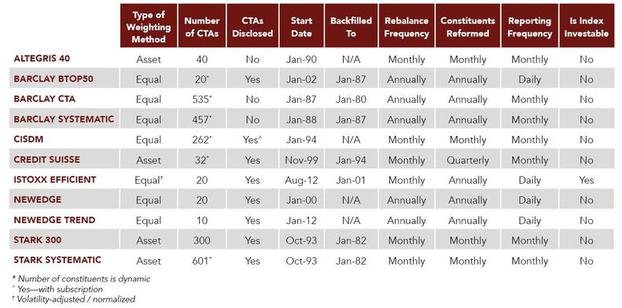Analysis of CTA Indices
Copyright © 2003-2016 Red Rock Capital, LLC. All rights reserved.
The risk of loss in trading commodities & futures contracts can be substantial. You should therefore carefully consider whether such trading is suitable for you in light of your financial condition. The high degree of leverage that is often obtainable in commodity trading can work against you as well as for you. The use of leverage can lead to large losses as well as gains. In some cases, managed commodity accounts are subject to substantial charges for management and advisory fees. It may be necessary for those accounts that are subject to these charges to make substantial trading profits to avoid depletion or exhaustion of their assets. The disclosure document contains a complete description of the principal risk factors and each fee to be charged to your account by the Commodity Trading Advisor. The regulations of the Commodity Futures Trading Commission require that prospective clients of a CTA receive a disclosure document at or prior to the time an advisory agreement is delivered and that certain risk factors be highlighted. This document is readily accessible from Red Rock Capital, LLC. This brief statement cannot disclose all of the risks and other significant aspects of the commodity markets. Therefore, you should thoroughly review the disclosure document and study it carefully to determine whether such trading is appropriate for you in light of your financial condition. The CFTC has not passed upon the merits of participating in this trading program nor on the adequacy or accuracy of the disclosure document. Other disclosure statements are required to be provided you before a commodity account may be opened for you.
Descriptive Information
In the above table, rebalance frequency refers to how often the index is reset back to its original weighting scheme. The annual rebalancing methodology of the equal weighted Barclay and Newedge indices has the effect that during the calendar year between rebalancing, the effective weight or contribution of well performing constituents increase relative to poorer performing constituents. In this way, the hypothetical portfolio of the initial equal weighted constituents become unbalanced over time; hence the need to rebalance. Technically, rebalancing only has significance when the index reporting period is different than the rebalance period. If the index reporting period is the same as the rebalance period, the index never has a chance to become unbalanced.
Is an asset weighted index better than an equal weighted index? The answer will depend on what aspect of the Managed Futures space the reader is interested in. An asset weighted approach is more represen-tative of the total assets under management (AUM) in the space. On the other hand, weighting is more representative of the diversity of different trading styles. They both have merit. If one wants to gauge the performance of the majority of AUM allocated to Managed Futures, then they should focus on an asset weighted index. If, however, they are interested in how the average program did, then they should concentrate their focus on an equal weighted index.
Are more constituents better than fewer? The number of constituents in an index is a measure of how
broadly the index represents the performance of CTA programs. Since the large majority of assets in the
Managed Futures space are concentrated in a relatively small number of the largest managers, the number of constituents in an asset weighted index becomes less significant once the number of consti-tuents in the index represents the large majority of assets being managed in the space. For an equal weighted index, the more constituents represented in the index, the more broadly the index represents the entire diversity of CTA programs in the Managed Futures space. Additionally, rebalancing and reconstit-ution events have a bigger impact with a smaller number of constituents since each constituent has a larger percentage impact on the index as a whole, i.e. with 500+ constituents, dropping, adding, or rebalancing will not have much impact on the entire index.
Some indices have been designed to be easily replicated in an investable product, such as the Barclay
BTOP50 Index, both the Newedge CTA Index and the Newedge Trend Index and the relatively new
iSTOXX Efficient Capital Managed Futures Index. Such indices will necessarily have fewer constituents
and qualify constituents by size. These qualifications are necessary to facilitate the practical considerations of actually replicating the index methodology, particularly the issues of manager capacity, reallocation, and rebalancing events.
